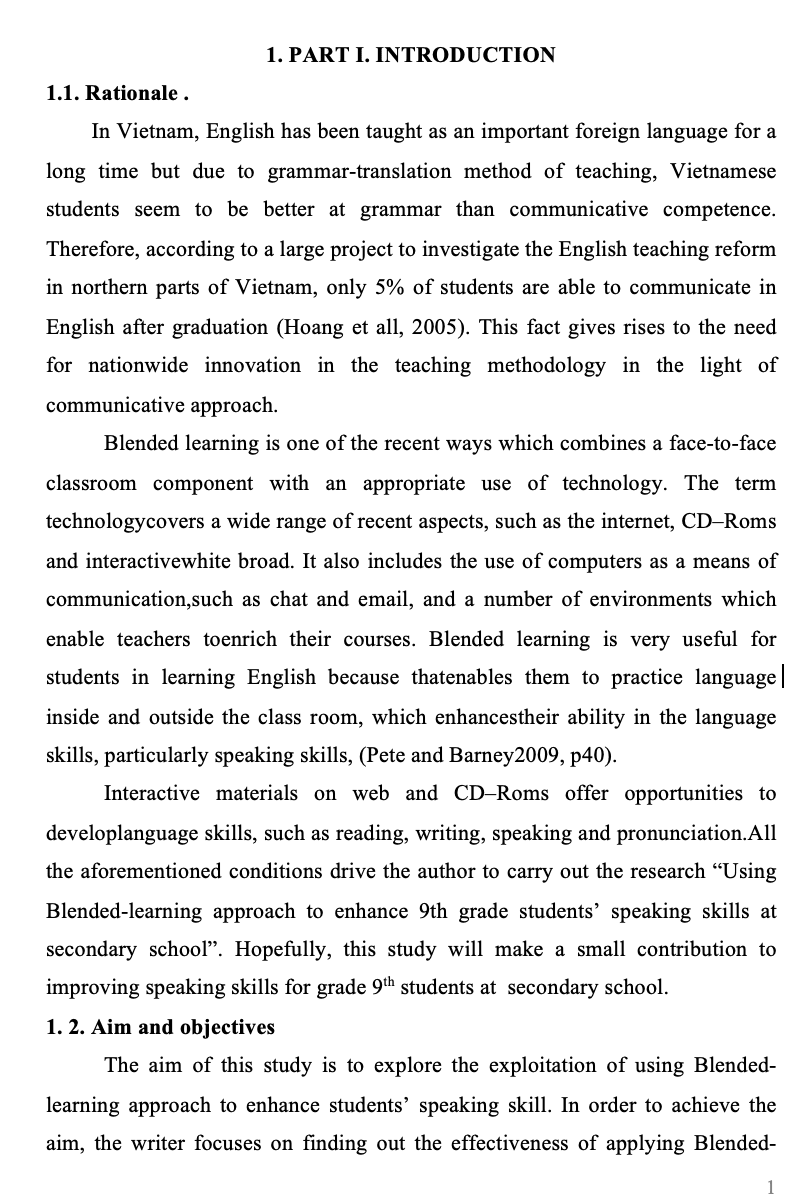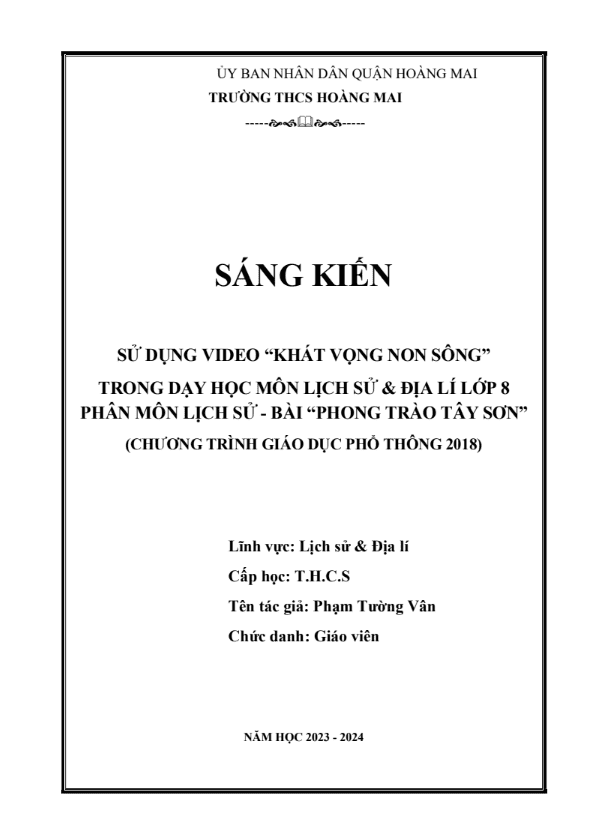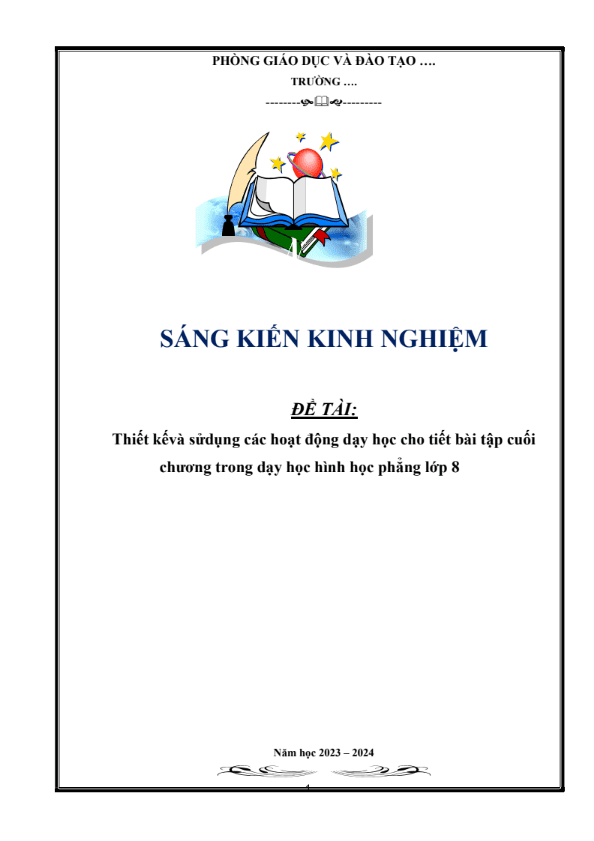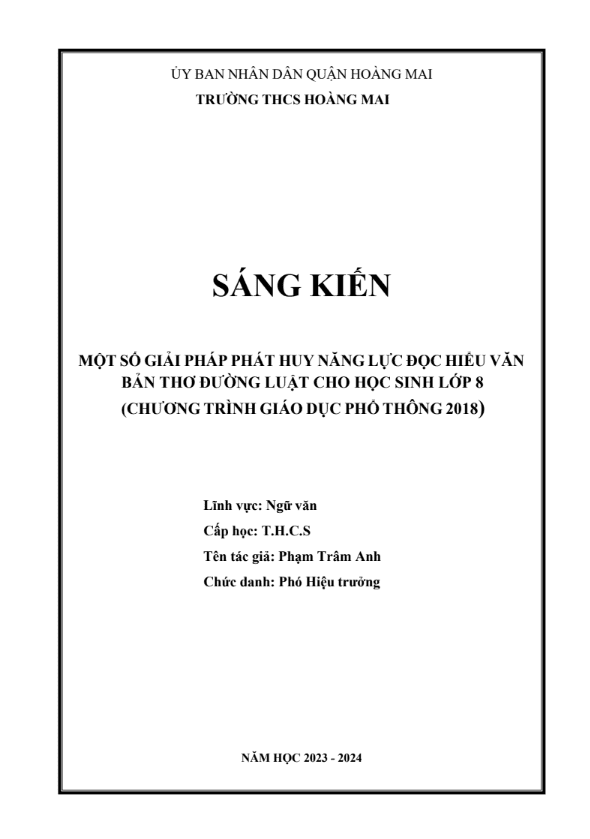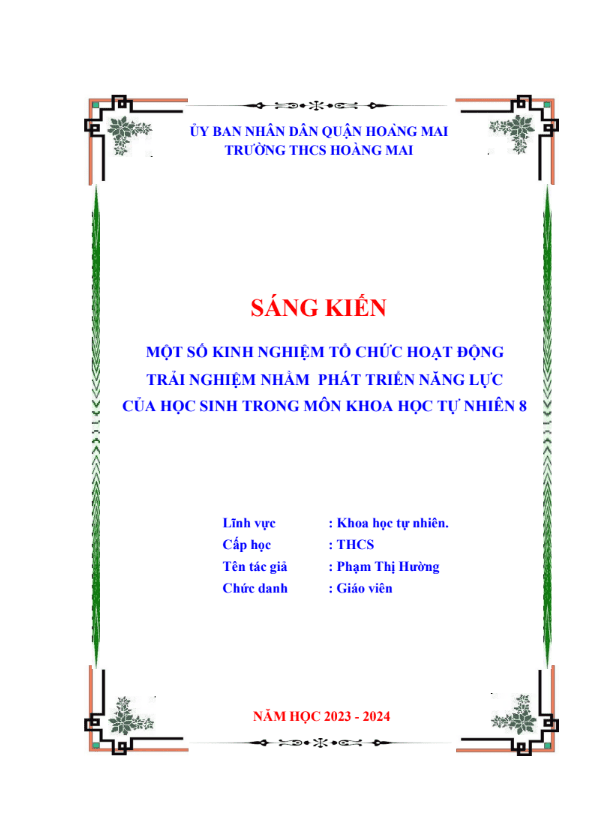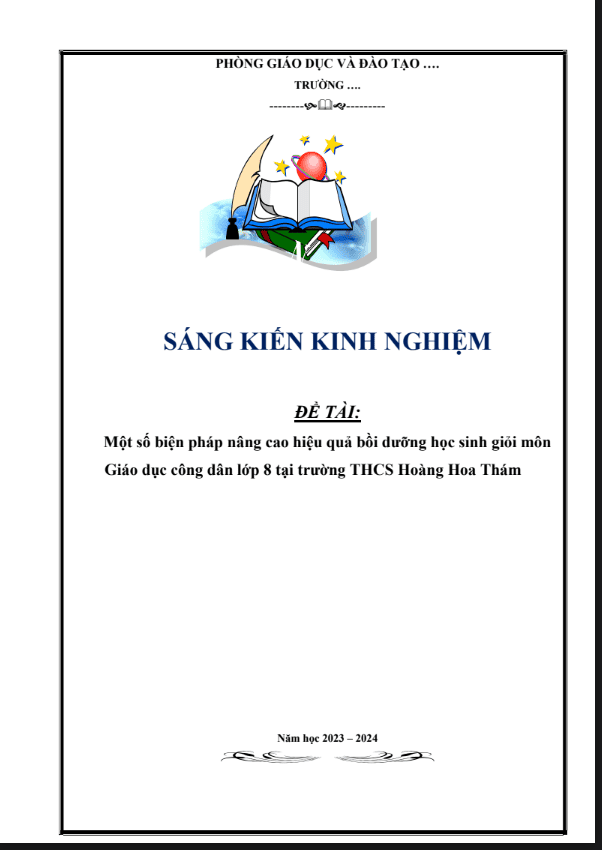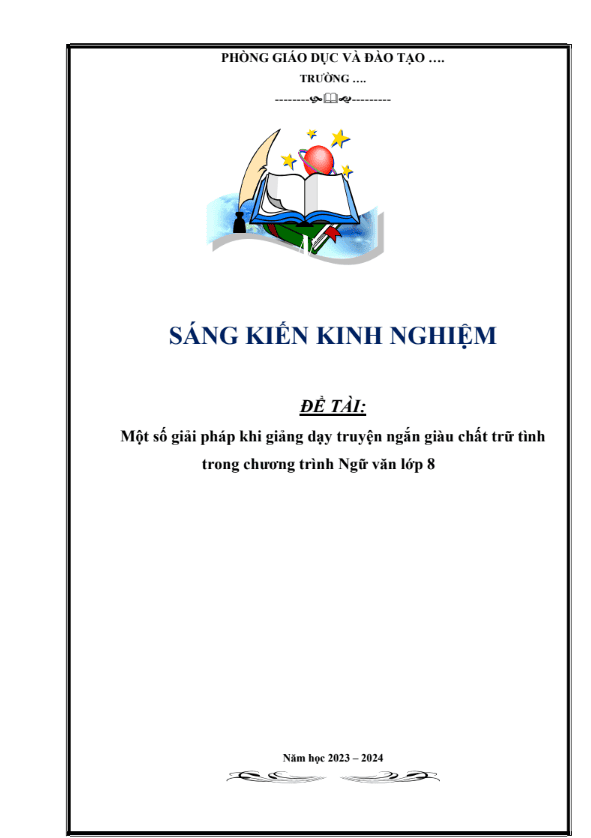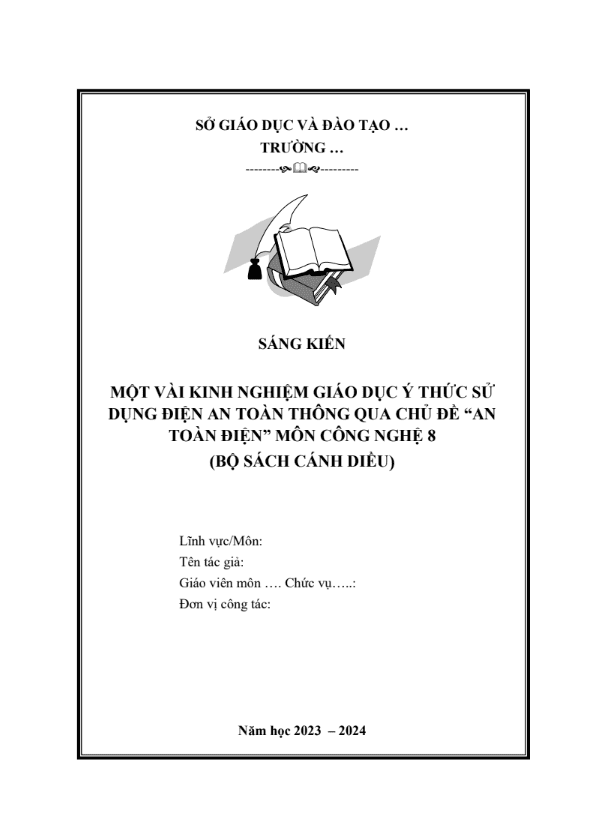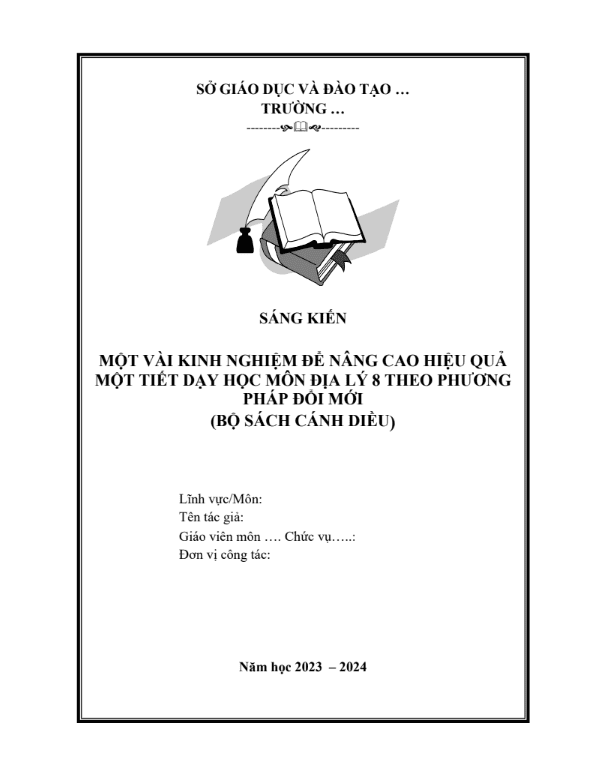SKKN Using Blended-Learning approach to enhance 9th grade students’ speaking skills
- Mã tài liệu: BM9229 Copy
| Môn: | Tiếng anh |
| Lớp: | 9 |
| Bộ sách: | |
| Lượt xem: | 783 |
| Lượt tải: | 5 |
| Số trang: | 24 |
| Tác giả: | Đặng Thị Minh Anh |
| Trình độ chuyên môn: | Cử nhân đại học |
| Đơn vị công tác: | Trường THCS Xuân La |
| Năm viết: | 2021-2022 |
| Số trang: | 24 |
| Tác giả: | Đặng Thị Minh Anh |
| Trình độ chuyên môn: | Cử nhân đại học |
| Đơn vị công tác: | Trường THCS Xuân La |
| Năm viết: | 2021-2022 |
Sáng kiến kinh nghiệm “SKKN Using Blended-Learning approach to enhance 9th grade students’ speaking skills” triển khai gồm các biện pháp nổi bật sau:
In planning, the teacher prepared syllabus, lesson plan, source of online learning, blended learning strategy based on the English 9 curriculum of the Vietnamese ministry of education and training. To reach the stated goal, the action plan is executed during the second semester. The project comprises two phases (12 weeks, second semester ……….).
The latter toughens such awareness and strategies in learners by involving them in the speaking practice. This stage is of great importance since only raising student’s awareness cannot ensure the raise in the autonomy level.
Teachers ought to provide thenecessary resources to adjust these instructions to fit students’learning needs and see how students make use of this toolto learn.
Mô tả sản phẩm
- PART I. INTRODUCTION
1.1. Rationale .
In Vietnam, English has been taught as an important foreign language for a long time but due to grammar-translation method of teaching, Vietnamese students seem to be better at grammar than communicative competence. Therefore, according to a large project to investigate the English teaching reform in northern parts of Vietnam, only 5% of students are able to communicate in English after graduation (Hoang et all, 2005). This fact gives rises to the need for nationwide innovation in the teaching methodology in the light of communicative approach.
Blended learning is one of the recent ways which combines a face-to-face
classroom component with an appropriate use of technology. The term technologycovers a wide range of recent aspects, such as the internet, CD–Roms and interactivewhite broad. It also includes the use of computers as a means of communication,such as chat and email, and a number of environments which enable teachers toenrich their courses. Blended learning is very useful for students in learning English because thatenables them to practice language inside and outside the class room, which enhancestheir ability in the language skills, particularly speaking skills, (Pete and Barney2009, p40).
Interactive materials on web and CD–Roms offer opportunities to developlanguage skills, such as reading, writing, speaking and pronunciation.All the aforementioned conditions drive the author to carry out the research “Using Blended-learning approach to enhance 9th grade students’ speaking skills at Thi Tran secondary school”. Hopefully, this study will make a small contribution to improving speaking skills for grade 9th students at Thi Tran secondary school.
1. 2. Aim and objectives
The aim of this study is to explore the exploitation of using Blended-learning approach to enhance students’ speaking skill. In order to achieve the aim, the writer focuses on finding out the effectiveness of applying Blended-learning approach in guiding students how to improve their speakingcapability and proposing strategies to teach speaking skills using Blended-learning approach.
1. 3. Scope of the study
Acquiring speaking skill is a vast issue in language learning. However, due to the limit of time, experiences and knowledge, this study touches upon only some applications of Blended-learning approaches which are used in teaching speaking skill and cannot cover all the speaking techniques in teaching and learning.
1.4. Methodology
The major method which was used in study is qualitative. All comments, remarks, assumptions and conclusions of the study were based on the data and analysis. Data collections for analysis in the study were gained through the following resources: survey questionnaire, observations, as well as reference books. After the data were collected, they were categorized and analyzed quantitatively and qualitatively to obtain the realistic results.To end with, based on analysis of survey results and references, some pedagogical implications and suggestions in order to improve teaching and learning English speakingskill using Blended-learning approach will be proposed.
1. 5. Significance
This study points out the effectiveness in applying Blended-learning approach in speaking lessons andIncrease the students’ achievement in English language as well as improve theirspeaking skills.More importantly, it offers some suggestions for teachers to enhance students’ English speaking competence through the use of Blended-learning approach. Hopefully, the findings and recommendations of this study will be of some help to the improvement of the teaching and learning speaking skill for Thi Tran secondary students.
2. PART II: DEVELOPMENT
- 1. Theory background
2.1.1. Speaking skills
2.1.1.1. The definition of speaking skills
The teacher has found several definitions of speaking as follows: Channey(1998, p.13) stated that ” speaking is the process of building and sharing meaningthrough the use of verbal and non- verbal symbols in a variety of contexts” In the other words, speaking is a skill which need the speaker to interact with others deeply to be perceived and understood, then constructing the meaning, pronouncing, and being fluent and accurate in using grammar and vocabulary..
From the above display, the teacher notice the ability to speak aforeign language involves several components that speaker need to acquire in order tocommunicate effectively. She also added communicative competence must includenot only the linguistic form of a language but also knowledge of when, how and towhom it is appropriate to use this form. However, in Vietnam, as the exam-oriented ways of teaching in secondary schools and no speaking part is included in high school entrance examination, English learning generally emphasizes more on the reading and writing skills than listening and speaking skills.
2.1.1.2. The speaking competences
To carry out a successful speaking task, the following competences should be acquired:
Initiating a conversation: Knowing how and when to open a conversation is akey speaking competence that learners must be taught. A study by Mc Cathy and O’keeffe (2004, p. 5) has shown that much classroom conversation involves the teacher taking the role of an initiator.
Turn-taking: This is the interaction management skill that learners would do well to acquire what.Bygate (1998: p.65) and Flucher (2003, p. 24) illustrate that turntaking and adjacent–pair practice will provide learners within dispensable knowledge of when it is appropriate to listen and talk, for how long, and the preferred response pattern to adopt.
Verbal and non–verbal symbols: It is the ability to convey meaning by encompassing appropriate expressions verbal and non–verbal in the proper context. Channey (1998, p. 13) assures that speaking through the use of verbal and non- verbal symbols in a variety of contexts.
Participation, interaction and engagement: To create English Language Classroom that is full of fun and a dynamic place to be, right activities should be taught in the right way. Speaking in the class can be a lot fun, raising general motivation. Consequently, Sari (2011, p. 2) adheres to the idea that if the students do not learn how to speak in the language classroom, they may soon get bored and lose interest in learning the foreign language.
It has become increasingly clear that success in school is a product of learning the language. Interacting through talking at home and in school is essential in bringing about oral language fluency and ultimately literacy.
2.1.1.3. Elements of speaking ability
Heaton(1988) divided the elements of speaking ability into three parts:
Accuracy: Pronunciation maybe heavily influenced by native language but
should be generally intelligible. No confusing errors of grammar or vocabulary. Accuracy in speaking means someone can produce correct sentences in pronunciation, grammar and word choice so can be understood. There are three components accuracy: pronunciation, Vocabulary, and grammar.According to Webster Dictionary (2003)pronunciation is the way in which a word is pronounced, the spelling of words in accordance with their usual pronunciation. Pronunciation teaching deals with recognition or understanding the flow of speech and production of words.
TÀI LIỆU LIÊN QUAN
- 0
- 114
- 1
- [product_views]
- 2
- 163
- 2
- [product_views]
- 3
- 183
- 3
- [product_views]
- 0
- 124
- 4
- [product_views]
- 0
- 134
- 5
- [product_views]
- 0
- 109
- 6
- [product_views]
- 5
- 101
- 7
- [product_views]
- 7
- 117
- 8
- [product_views]
- 1
- 174
- 9
- [product_views]
- 8
- 179
- 10
- [product_views]

